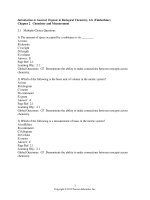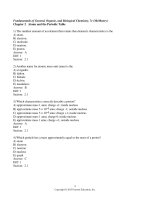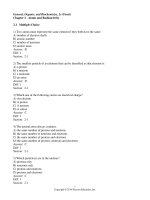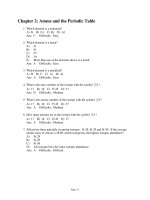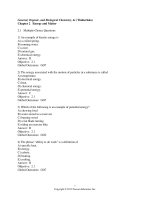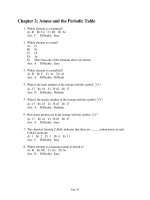Principles of general organic and biological chemistry 1st edition janice gorzynski smith test bank
Bạn đang xem bản rút gọn của tài liệu. Xem và tải ngay bản đầy đủ của tài liệu tại đây (176.62 KB, 7 trang )
Chapter 2: Atoms and the Periodic Table
1. Which element is a nonmetal?
A) K B) Co C) Br D) Al
Ans: C Difficulty: Easy
2. Which element is a metal?
A) Li
B) Si
C) Cl
D) Ar
E) More than one of the elements above are metals.
Ans: A Difficulty: Easy
3. Which element is a metalloid?
A) B B) C C) Ar D) Al
Ans: A Difficulty: Difficult
4. What is the mass number of the isotope with the symbol
A) 17 B) 18 C) 35.45 D) 37
Ans: D Difficulty: Medium
37
17
5. What is the atomic number of the isotope with the symbol
A) 17 B) 18 C) 35.45 D) 37
Ans: A Difficulty: Medium
6. How many protons are in the isotope with the symbol
A) 17 B) 18 C) 35.45 D) 37
Ans: A Difficulty: Easy
37
17
Cl ?
37
17
Cl ?
Cl ?
7. The chemical formula C3H6O2 indicates that there are _____ carbon atoms in each
C3H6O2 molecule.
A) 1 B) 2 C) 3 D) 6 E) 11
Ans: C Difficulty: Easy
8. Which element is a transition metal in period 4?
A) K B) Db C) Ga D) Sc
Ans: D Difficulty: Easy
Page 10
Chapter 2: Atoms and the Periodic Table
9. Which element is a noble gas?
A) H
B) Ne
C) Pr
D) Ra
E) More than one of the elements listed is a noble gas.
Ans: B Difficulty: Easy
10. Which element is not an alkali metal?
A) Li B) K C) Rb D) H E) All of the above elements are alkali metals.
Ans: D Difficulty: Difficult
11. Which element is not an alkali metal?
A) Li B) Kr C) Rb D) Na E) All of the above elements are alkali metals.
Ans: B Difficulty: Medium
12. The chemistry of an element is determined by the number of _____ in an atom.
A) protons B) electrons C) neutrons
Ans: B Difficulty: Easy
13. The element symbol for manganese is
A) M. B) Ma. C) Mg. D) Mn.
Ans: D Difficulty: Medium
14. The element symbol for sulfur is
A) S. B) Su. C) Sf. D) Sl.
Ans: A Difficulty: Easy
15. Which statement is not part of the modern description of the electronic structure of an
atom?
A) Electrons occupy discrete energy levels.
B) Electrons move freely in space.
C) The energy of electrons is quantized.
D) The energy of electrons is restricted to specific values.
Ans: B Difficulty: Difficult
16. What is the maximum number of electrons that can occupy the n = 3 shell?
A) 1 B) 3 C) 6 D) 8 E) 9 F) 18
Ans: F Difficulty: Difficult
17. Which atom is the largest?
A) K B) Ga C) Br D) Rb
Ans: D Difficulty: Medium
Page 11
Chapter 2: Atoms and the Periodic Table
18. Which atom is the smallest?
A) K B) Ga C) Br D) Rb
Ans: C Difficulty: Medium
19. Which element has the smallest ionization energy?
A) K B) Ga C) Br D) Rb
Ans: A Difficulty: Medium
20. How many protons are in the isotope
A) 238 B) 146 C) 92 D) 330
Ans: C Difficulty: Medium
238
92
U?
21. How many neutrons are in the isotope
A) 238 B) 146 C) 92 D) 330
Ans: B Difficulty: Medium
238
92
22. How many electrons are in the isotope
A) 238 B) 146 C) 92 D) 330
Ans: C Difficulty: Medium
238
92
U?
U?
23. Which isotope is not possible?
A) 11 H
B)
C)
D)
4
9
241
95
Be
Am
2
1
H
E) More than one of the above isotopes is not possible.
Ans: B Difficulty: Difficult
24. An atom of the isotope chlorine-37 consists of how many protons, neutrons, and
electrons? (p = proton, n = neutron, e = electron)
A) 18 p, 37 n, 18 e
D) 37 p, 37 n, 17 e
B) 17 p, 20 n, 17 e
E) 37 p, 20 n, 37 e
C) 17 p, 20 n, 18 e
Ans: B Difficulty: Medium
25. The elements in a column of the periodic table are known as
A) metals. B) a period. C) a group. D) a series. E) metalloids.
Ans: C Difficulty: Easy
26. Which element is most likely to be a good conductor of electricity?
A) Ar B) N C) F D) Ni E) O
Ans: D Difficulty: Medium
Page 12
Chapter 2: Atoms and the Periodic Table
27. Which element is chemically similar to lithium?
A) sulfur B) magnesium C) iron D) lanthanum
Ans: E Difficulty: Medium
E) potassium
28. Which element is chemically similar to chlorine?
A) sulfur B) calcium C) oxygen D) bromine E) argon
Ans: D Difficulty: Easy
29. The electron-dot symbol for aluminum is _____.
A)
Ans: A
B)
C)
Difficulty: Easy
D)
30. What is the symbol for the isotope with A = 31 and Z = 15?
31
31
A) 15
B) 46
C) 15
P
Ga D) 15
31 P
15 P
Ans: D Difficulty: Medium
31. An alloy is a mixture of two or more elements that has metallic properties.
Ans: True Difficulty: Easy
32. The correct element symbol for sodium is So.
Ans: False Difficulty: Easy
33. The correct element symbol for iron is Fe.
Ans: True Difficulty: Easy
34. Nonmetals have a shiny appearance, and they are generally poor conductors of heat and
electricity.
Ans: False Difficulty: Easy
35. Calcium, aluminum, lead, and nitrogen are all metals.
Ans: False Difficulty: Easy
36. Every element has at least two naturally occurring isotopes.
Ans: False Difficulty: Medium
37. Oxygen, carbon, hydrogen, and calcium are called the building-block elements.
Ans: False Difficulty: Difficult
38. A compound is a pure substance formed by chemically combining two or more atoms
together.
Ans: False Difficulty: Medium
Page 13
Chapter 2: Atoms and the Periodic Table
39. The farther a shell is from the nucleus, the larger its volume becomes, and the more
electrons it can hold.
Ans: True Difficulty: Easy
40. The mass of a neutron is equal to the mass of a proton plus the mass of an electron.
Ans: False Difficulty: Easy
41. The mass of an atom is concentrated in the nucleus.
Ans: True Difficulty: Easy
42.
The electron-dot symbol for barium is
Ans: False Difficulty: Easy
.
43. All of the elements in group 2A are metals.
Ans: True Difficulty: Easy
44. All of the elements in group 6A are nonmetals.
Ans: False Difficulty: Medium
45. All metals are solids at room temperature.
Ans: False Difficulty: Medium
46. The maximum number of electrons that can be contained in the 3d orbitals is 10.
Ans: True Difficulty: Medium
47. Chlorine has 17 valence electrons.
Ans: False Difficulty: Medium
48. A potassium atom is smaller than a bromine atom.
Ans: False Difficulty: Medium
49. Iodine has a smaller ionization energy than chlorine.
Ans: True Difficulty: Easy
50. The electron configuration for sodium is 1s22s22p63s2.
Ans: False Difficulty: Medium
51. Group 6A elements have the general electron configuration of ns2np6.
Ans: False Difficulty: Medium
52. The electron cloud contains most of the volume of an atom.
Ans: True Difficulty: Easy
53. Bromine is abbreviated by the two-letter symbol BR.
Ans: False Difficulty: Easy
Page 14
Chapter 2: Atoms and the Periodic Table
54. A period in the periodic table is the same as a group.
Ans: False Difficulty: Easy
55. An atom with A = 23 and Z = 11 is an isotope of an atom with A = 22 and Z = 11.
Ans: True Difficulty: Easy
56. The atomic weight is the average of the masses of the naturally occurring isotopes of a
particular element.
Ans: False Difficulty: Difficult
57. Strontium and barium have similar chemical properties.
Ans: True Difficulty: Easy
58. The number of electrons that an orbital can contain depends on the type of orbital.
Ans: False Difficulty: Medium
59. A cation is positively charged, and has more electrons than the neutral atom.
Ans: False Difficulty: Medium
60. Fluorine has a higher ionization energy than neon.
Ans: False Difficulty: Medium
61. An iodine atom is larger than both a krypton atom and a tellurium atom.
Ans: False Difficulty: Difficult
62. Radium is a noble gas.
Ans: False Difficulty: Difficult
63. The ground state electron configuration for _____ is 1s22s22p4.
Ans: oxygen
Difficulty: Medium
64. The electrons in the outermost shell are called the _____ electrons.
Ans: valence
Difficulty: Medium
65. _____ is an alkali metal in period 5.
Ans: Rb or rubidium
Difficulty: Easy
66. The isotope 4922Ti has A = _____ and Z = _____.
Ans: 49, 22
Difficulty: Medium
Page 15
Chapter 2: Atoms and the Periodic Table
67. Two isotopes of the same element have the same _____.
Ans: number of protons
Difficulty: Easy
68. Elements in the same group have the same number of _____.
Ans: valence electrons
Difficulty: Easy
69. Iron-56 contains _____ neutrons.
Ans: 30
Difficulty: Medium
Page 16

